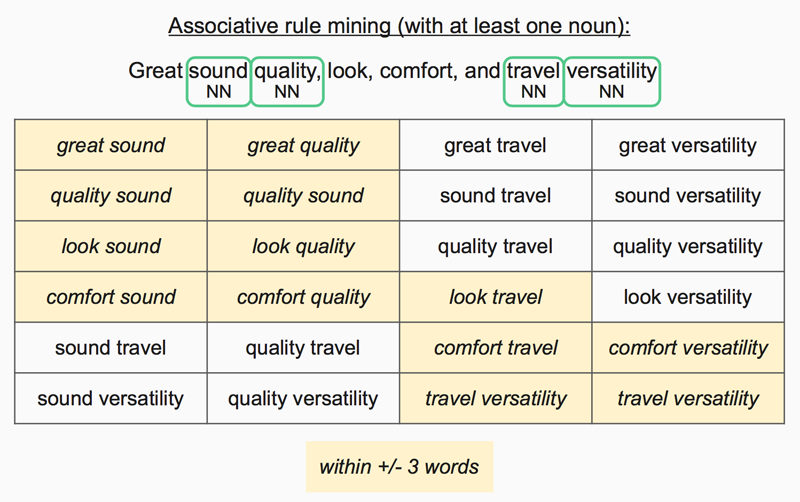This project was developed as a capstone project for Galvanize's Data Science Immersive course.
See sample results here
Amazon has one of the largest corpus or reviews out there on the internet, but there is no feature that highlights how frequently word terms appear in the reviews for a product. This is implemented in other sites like yelp, glassdoor, and tripadvisor. Review highlights provide a simple way for consumers to get a snapshot of what people review about without sifting through a ton of reviews. Example of review highlights in yelp:
The goal of Amazon Review Summarizer is to build a web application that can execute the following tasks for any product on amazon:
- Extract common aspects from a corpus of reviews
- Perform opinion mining (positive and negative polarity) on top aspects
Amazon Review Summarizer also includes a tool for side-by-side product comparison. Given any two related products, a consumer will be able to compare the sentiments for any top aspect common to both products. Here are example results from the application.
The main pipeline for Amazon Review Summarizer is composed of 6 steps:
- Scrape the 300 most helpful Amazon reviews for the input product url(s).
- Perform dependency parsing and part of speech tagging on every sentence in every scraped review.
- Collect all nouns used in the reviews as candidate unigram aspects. Filter out unigrams that are unlikely to be aspects.
- Perform association rule mining to find candidate bigram and trigram aspects. Use set of words obtained from Step #3 and compactness pruning to filter out bigrams that are unlikely to be aspects. Connect set of bigram words that appear frequently together in same sentences into trigrams.
- Perform sentiment analysis and label reviews as either positive sentiment, negative sentiment, or mixed sentiment (unable to predict the sentiment polarity).
- Display sentiment analysis results for the top 10 frequent aspects.
- Tokenization
- Split reviews into sentences
- Part of Speech (POS) tagging
- Tag each word of sentence with its contextual part of speech
- Collect words used in noun context as candidate unigram aspects
- Dependency Parsing
- Lemmatization
- Lemmatize words into root form to count aspect frequency across all sentences and user reviews
- Associative Rule Mining
- AMOD %:
the percentage of AMOD dependencies (link from a noun to an adjective modifier) among all the dependencies of an unigram aspect - Average Word Distance:
average absolute distance between bigrams words across all sentences in all reviews - PMI (pointwise mutual information):
a measure of association of two words with respect to the frequency each individual words appear
Evaluated the model against products with over 1000+ reviews in a publicly available Amazon dataset. I individually hand-labeled data and chose tuning parameters based on accuracy against the majority class baseline.
| CATEGORY | DATASET | ENGINEERED FEATURES | ACCURACY | BASELINE |
|---|---|---|---|---|
| Unigrams | Top 20 frequent unigrams per product | AMOD % | 74% | 63% |
| Bigrams | Top 20 frequent bigrams per product | Average Word Distance; PMI | 82% | 63% |
TextBlob and Afinn sentiment analysis packages were used to obtain polarity scores on sentences containing aspects. If a review contained multiple sentences containing the aspect under evaluation, all the sentences from the review containing the aspect were combined together and passed through the sentiment analyzer.
To evaluate the effectiveness of these packages, random sentences were sampled and hand-labeled with positive, negative, or neutral sentiment labels. A decision tree like model was used (with polarity scores and customer rating of review as a whole as features) to make a sentiment prediction on the aspect, and the effectiveness was evaluated based on accuracy against the baseline for the star rating (1-2 stars = negative, 3 stars = neutral, 4-5 stars = positve).
| CATEGORY | DATASET | ENGINEERED FEATURES | ACCURACY | BASELINE |
|---|---|---|---|---|
| Sentiment | 200 random sentences with aspects from every star rating | Polarity scores from textblob, afinn sentiment analysis packages | 72% | 56% |
- Anaconda
- afinn
pip install afinn - celery
pip install celery - mongoDB
- pymongo
pip install pymongo - redis
- spacy
- textblob
pip install textblob
- Install required packages
- Start mongoDB with the following command:
sudo mongod - Start mongo with the following command:
mongo - Start redis with the following command:
redis-server - Start celery with the following command from the app folder:
celery -A app.celery worker - Start flask app with the following command from the app folder:
python app.py
- amadown2py
- Hu & Liu's Mining and Summarizing Customer Reviews (2004)
- Hu & Liu's Mining Opinion Features in Customer Reviews (2004)
- Bing Liu's Sentiment Analysis and Opinion Mining (2012)
- Stanford dependency hierarchy




